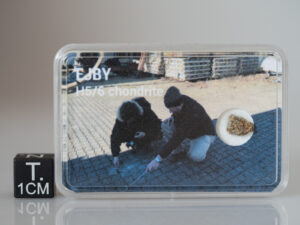Description
Extremely rare meteorite that fell in Poland in 2021.
Reclassified as Chondrite L4-5 on July 31, 2024.
Antonin 51°30’48.473″N, 17°54’17.078″E
Kalisz, Poland
Fall: 2021 Jul 15
Classification: Ordinary chondrite (L5)
History: (P. Spurný, L. Shrbený and J. Borovi?ka, CzAS, Z. Tymi?ski, RC POLATOM, K.Kmieciak) Three video cameras of the Czech part of the European Fireball Network recorded a daylight fireball on July 15, 2021, at 3:00:11-15 UT. Based on these instrumental data, precise results on atmospheric trajectory (the whole trajectory was over the territory of Poland), heliocentric orbit, and fragmentation history were quickly determined. From this analysis, it was evident that this event likely resulted in a multiple meteorite fall. The impact site for possible range of meteorite masses was modeled and a couple of days after the fall sent to Polish colleagues and also publically shared on the website of the CzAS. Two weeks after (on August 3, 2021), one fresh piece of meteorite (352 g) has been recovered during a dedicated recovery expedition exactly in the predicted impact location for a given mass.
Physical characteristics: (Z. Tyminski, RC POLATOM, A. Krzesinska, UOslo) A specimen 350 g in mass, almost fully crusted by thick fusion crust. Chondritic texture easily distinguishable inside. Specimen is fresh. Within two weeks from the recovery, the meteorite was analysed for concentrations of cosmogenic radionuclides by means of nondestructive high purity germanium (HPGe) gamma spectroscopy (Z. Tyminski). Of the short and medium-lived cosmogenic radionuclides, 48V, 51Cr, 58Co, 56Co, 46Sc, 57Co, 54Mn, 22Na, 60Co, 7Be, 44Ti, and 26Al were positively identified. The data indicate fall date in the ragne of one month before measurements, which corroborates that the recovered specimen is fresh, and connected to fireball event.
Petrography: (A. Krzesinska, UOslo) Ordinary chondrite, compositionally well equilibrated. Many chondrules are retained and plagioclase crystals are rare and smaller than 50 µm. Instead, feldspathic glass with diopside microcrystallites is abundant in chondrule mesostasis and in matrix. Moderately shocked, with undulose light extinction of olivine and shock melt pockets at contacts of metal and plagioclase. Additionally, plessitic intergrowths in metal are present, as well as mosaic sulfides with intergrowths of troilite and mackinawite. No indications of brecciation seen in specimen or thin section.
Geochemistry: Mineral Composition and Geochemistry: (A. Krzesinska, UOslo) EPMA results indicate well equilibrated olivine with Fa24.4 (Fa23.9-25.1, n=23), orthopyroxene with Fs20.9Wo1.6 (Fs20.4-21.9Wo0.7-2.0, n=22). Plagioclase is rare and has An7.6Or6.7 (An6.9-9.0Or5.3-7.9, n=5), feldspathic glass with wide range of composition: up to An30Or15 (An8.2-24.7Or2.9-15.5, n=10). Submicrometer diopside crystallites in glass with Fs8.4Wo46.1 (Fs6.3-11.6Wo44.8-48.3, n=3). Among opaque minerals, the major one is taenite with 33.4 wt% Ni (29.9-36.5, n=11) and 0.22 wt% Co (0.12-0.45 wt%). Kamacite has 6.63 wt% Ni (6.1-7.1 wt% Ni, n=9) and 0.72 wt% Co (0.49-0.85). Accessory minerals include troilite, mackinawite with (Fe,Ni)/S=1.1, chromite, ilmenite, Cl-apatite (with up to 5wt% of Cl) and merrillite (up to 2.5 wt% Na2O and 3.5 wt% MgO).
Classification (A. Krzesinska, UOslo) Ordinary chondrite of L5 type, based on equilibrated composition of olivine, pyroxene as well as elemental composition of kamacite. Shock stage of S3 based on intracrystalline deformation of silicates, and local melting of metal-troilite and plagioclase. No weathering seen.
Specimens: (Z. Tyminski, K. Kmieciak, R. Mackowska) One specimen 352 g in mass (350 g dry mass) was found and subsampled for classification. The finder holds the main mass 315,7 g and Museum of the Earth PAS (MZP) curates type specimen (20.8 g, two slices 9.4 g + 11.4 g).




